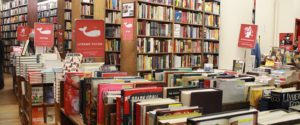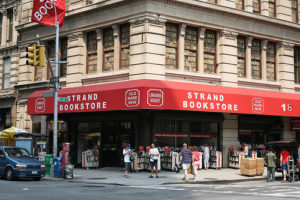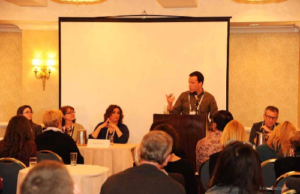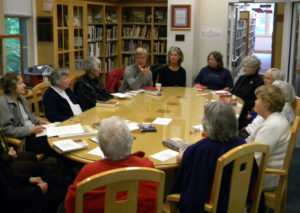 Recently I was looking for some books and as usual, I first tried to shop at bookstores in my community. Did it work out? No. I scored only one for seven and bought the rest online.
Recently I was looking for some books and as usual, I first tried to shop at bookstores in my community. Did it work out? No. I scored only one for seven and bought the rest online.
I admit I am a “long tail” customer. I don’t buy the latest New York Times bestsellers. I buy the books I select, not what the NYTimes selects.
So what was I looking to buy?
- Theodore Sturgeon: More than Human, A classic sci-fi title, still in print.
- Philip K. Dick: Ubik. Classic Sci-fi, still in print.
- Alain Badiou: Deleuze: The Clamor of Being. Philosophy.
- Trevor Noah: Born a Crime. Biography.
- David Wootton: The Invention of Science. History.
- Donald Johanson & Blake Edgar: From Lucy to Language. Science.
- Tim O’Brien: Going After Cacciato. Literary.
At considerable cost of time, I called and visited bookstores in my city with this list, to little avail. I did score the Trevor Noah biography at Barnes & Noble (hardly a mom & pop), and even though it was available only in hardback for the full $30 list price, I bought it because I had a $25 gift card that somebody gave me and which I’d been holding for over a year, unable to find anything to spend it on.
The other books were not easy to find even online. The Badiou volume especially, was listed at over $70 most places. Amazon had it for $25. I found a “like new” copy at Half-Price books for $10.
Going to a bookstore is generally a bad experience for me. As soon as I open the door, the books prominently featured-in-my-face are an assault on my sensibilities and interests, and the books I want are not there in the store at all. It didn’t used to be that way.
 Only a few bookstores I know of still capture that “good ol’ bookstore experience” of yesteryear: Powell’s in Portland, Oregon, and the Strand in Manhattan are two. Elliott Bay Books in Seattle used to be on the list but recently their inventory has narrowed significantly. Even Powell’s, on my last visit, seemed much thinner than I remember. Inventory is expensive, I know.
Only a few bookstores I know of still capture that “good ol’ bookstore experience” of yesteryear: Powell’s in Portland, Oregon, and the Strand in Manhattan are two. Elliott Bay Books in Seattle used to be on the list but recently their inventory has narrowed significantly. Even Powell’s, on my last visit, seemed much thinner than I remember. Inventory is expensive, I know.
I fear that physical bookstores are already anachronistic. But they don’t have to be. What would be the perfect bookstore?
- It has the books I want at prices I am willing to pay.
- It has so much inventory that new titles suggest themselves to me.
Impractical? No. Such stores used to exist. I think a perfect bookstore could still be built and operated and make money. Here’s how.
What the Perfect Bookstore Has:
- It uses the customer-facing floor space for people, not to run a warehouse. What an incredible waste of floor space and everybody’s effort, from the shelf-stockers to the customers, to have acres of inert books lined up row after row in alphabetical order by author. I am not going to browse books alphabetically by author. The probability of finding anything interesting that way is very close to zero.
- It has the store’s complete inventory online (as do Powell’s and Amazon) along with large, full-color computer kiosks every ten feet so I can search each category as I approach each small section of books on display.
- It includes with each book listed, bibliographic information, formats, prices, and reviews from the publisher, from critics, and from the public. Includes also intelligent links to related books. By intelligent, I mean to associated topics and authors, not merely a list of every other book by that author (though that is helpful). What I need is what the publishing industry calls “comparables,” books similar in theme, tone, genre and diction. Those links could be put in by reviewers or intelligent staff members.
- It has a staff of well-read clerks to find and recommend. Clerks are expensive, of course, so as an alternative, have good signage and very intelligent info-kiosks.
- It has attractive collections of well-reviewed current releases and classics displayed for browsing and purchase. It does not have publisher-purchased placements which have nothing to do with quality. It does not have piles of used books, which are unbrowsable. It does not have racks and racks of backlist and classics that are also unbrowsable. The Strand usually has some interesting sales tables with labels like “Books You Say You’ve Read But Haven’t.”
- Optional: Current magazines. There is a magazine for every conceivable human interest, no matter how obscure. Browsing those can be fun but not necessary. I’d like to see only the two or three-dozen magazines that airports usually have, on current events, literary, and science/technical topics, and the like. Discounts off cover would be necessary, as most magazines are overpriced.
- Book reviews, like the New York Times book review, Paris Review, LARB, New York Review of Books, etc.
- Optional: Audio books and even DVD videos (although the latter are quickly going the way of the dinosaur).
- Optional: Textbooks. I love textbooks. Not the 1000-page statistics or accounting book, but the many fascinating paperbacks usually sold as “supplementary reading” especially for introductory courses. I try to visit my local university bookstore just before classes begin to browse these and I usually come away with something, but it’s difficult to time it right. The students scour those shelves like locusts, and anyway, I don’t want to deprive some student of his or her required book. Wouldn’t it be nice if such books were available elsewhere and all year? The same goes for books used in adult education courses that run all year ‘round.
- Optional: Buybacks. Many stores, like Powell’s sell a mix of new and used books. The local Bookman’s in my town offers you about five cents on the dollar cash for your books or about fifty cents per dollar of cover price in store trade. Keeps you coming back. They recycle a lot of books that way. However, since they sell 95% used books, not new, their inventory ends up being mostly discards: the worst of the best and the best of the worst. So I hardly go there anymore. But a mix of new and used is a good idea.
- Meeting Space. Get rid of all that book warehouse space and turn it into
 community meeting space, which is sorely lacking in most towns and cities. The space can be used for traditional book release events and signings but also for readings by local and other authors, kids’ book events, and so on. This should be a large community space, not a cramped aisle between shelves with a few chairs crammed in. Big and open (though surrounded by books) with comfortable (padded) folding chairs. The space should be configured so it can be redeployed, perhaps with sales tables on wheels when not in use. Prairie Lights in Iowa City does a good job of this.
community meeting space, which is sorely lacking in most towns and cities. The space can be used for traditional book release events and signings but also for readings by local and other authors, kids’ book events, and so on. This should be a large community space, not a cramped aisle between shelves with a few chairs crammed in. Big and open (though surrounded by books) with comfortable (padded) folding chairs. The space should be configured so it can be redeployed, perhaps with sales tables on wheels when not in use. Prairie Lights in Iowa City does a good job of this. - Even More Meeting Space. Have meeting rooms that can be used by community groups such as book clubs and writers groups. Simple, airy with chairs and a few tables. If the inevitable coffee shop is nearby, require a minimum purchase to pay the rent. This makes the bookstore a genuine community center that people feel is an important part of their lives, not merely a warehouse of overpriced books.
- Programs for readers. Book reviewers and staff give presentations of the latest “beach read” or thriller, for example. Book clubs are organized around a selected volume announced in advance and discussed in open forum. Local authors tout their works. There should be at least two such events every day of the week for all levels and categories of readers, including a few in alternate languages such as Spanish, or whatever is appropriate for the surrounding community.
- Programs for writers. Experts (who usually have a book to sell) talk about the craft of writing and provide instruction and maybe even writing time, maybe even critique, focusing on all levels of craft for all levels of writers. Writing contests are announced and judged and winners are honored and interviewed. At least two writing events every day of the week for all ages, all genres.
- Programs for literacy. Experts and local activists promote literacy outreach in the community by staging organizing events and instruction for volunteers to bring books, readings and storytelling to schools, prisons, nursing homes, hospitals, neighborhoods. At least one event like this every week.
- Movie tie-in programs. Movies can be a gateway to books. A screening, or at least a review with clips, can be a draw that sells books on correlated topics. Works the same for theater. Especially good with documentaries.
The goal of the “Programs” above is to integrate the bookstore into the lives of its community members. (People have actually gotten married in the Strand Bookstore). The main goal is NOT to sell books at those events because that will result in “events” featuring mainly kittens, sunsets, trains and planes, self-help and sentimental fiction. It might be easier to sell books on those topics but that does not accomplish the goal of integrating the bookstore into the community, where long-term loyalty lies. Okay maybe that’s elitist. One “kitten” topic a quarter could be allowed.
What The Perfect Bookstore Does NOT Have:
- Sofas and upholstered chairs to read in. I don’t go to a bookstore to read. I go to acquire books and get out as quickly as I can. Those sofas and upholstered chairs usually look like health hazards anyway.
- Games, puzzles, CD’s, candy, luggage, t-shirts, bobble-head dolls and musical instruments. If I wanted to go to a gift shop, I would (actually I wouldn’t). However, genuinely germane non-book merchandise can be interesting and useful: booklights, book covers, tablets and their covers, book bags, lapboards, pens, notebooks, and so on.
- A coffee shop. That takes up a lot of space and is not necessary, and the quality of the coffee is usually quite bad, the prices high, the waits long, the tables filthy, the area crowded. However, it’s generally true that after having coffee I will buy more books, too many books. So maybe it’s okay to have a coffee shop if it’s well-staffed and can serve quickly. Why not try the Trader Joe’s model: Free 2 ounce coffee in a paper cup, for the crass purpose of making you buy more books?
- Rare books locked in glass cases. That’s a different business.
- Performing arts. Some performances might be related to a particular book, that’s okay but don’t drift into a concert venue. It’s a bookstore.
- Cats. It’s a bookstore.
The Delivery Problem
Supposedly, buyers at a physical store want the immediate satisfaction of taking the book home now. Maybe that’s true for some or most buyers, but it’s not feasible to satisfy that urge completely. By trying to do so, traditional bookstores have fallen into the self- defeating traps of
- Making the store into a vast warehouse to satisfy anyone. In fact that does not work. There are too many books, no matter how large the warehouse.
- Coercing customers into believing that what they want is what is for sale. But that’s the specialty of publisher’s marketing. The bookstore should try to serve, not exploit its customers.
What are some alternatives to the delivery problem?
- Have an enormous warehouse in the basement or upstairs, or next door, run by robots. Once I select my book from one of the big-screen kiosks, it is dispatched to the sales desk where my “shopping cart” will be rung up, bundled and bagged for me when I get there.
- Have several massive Print-on-demand machines in the back room where my selection is printed and bound in 15 minutes and ready for me to take home.
- Have a massive regional warehouse (as Amazon) and my selections will be available in the store for pickup (free delivery!) the next day. Even two-day delivery is okay. I don’t need it sent to my doorstep. Notify me by text or phone (as Walgreens does for prescriptions) and I’ll come back for it, especially if you offer me a free cup of coffee when I get there, which will probably make me buy more books.
- Optional: Have my choices available for immediate gratification as ebooks. I don’t like ebooks, but they are logically an option. Give the customer what they want. Why not ebooks? Because they’re too hard to make notes in, and they’re not stackable so I can’t see them waiting for me, calling out to me, nagging me. They’re too hard to skim, too hard track where I am in the reading process. Reading an ebook is like reading through a soda straw. It’s a last choice when price offers little alternative.
Can the Perfect Bookstore Make Money?
Physical bookstores are getting whipped on price, mainly by Amazon. They have taxes and building maintenance and retail staffing to pay. How can they compete? One simple answer: By becoming integral to the community they live in so that people see the bookstore not merely as “a place to buy a book,” but as a gathering place and a cultural institution. Selling books is almost a sideline, an incidental. Oh, by the way, we have a wonderful book on today’s topic.
Still: Can it make money? Truth is, I don’t know. If I was sure, I would do it. But I do know that:
- I would visit my local bookstores much more often if I had at least a 75% chance of being satisfied.
- I would pay a “subscription fee” to (e.g.) a lecture series if I felt I had at least a 75% chance of being satisfied.
- I would sign up for a well-crafted “monthly minimum advance purchase” scheme, such as “Five books for $100,” if it were tailored to me and I had a good chance of getting what I wanted.
- I would happily pay a reasonable rental fee to use the store’s meeting space for my book club, my writing club, and other literacy-related needs, if I had a good chance of being satisfied. I would happily pay a low fee for admission to movie reviews and serious book lectures (like on CSPAN’s “Book TV”).
- I would donate books, time, and money to literacy projects, if I believed in them.
- I would donate online reviews of books if I felt connected.
- And of course I would pay for the hundreds of books I would buy. I confess I balk at a $30 hardcover. That seems like gouging. It’s only words on paper, for heaven’s sake. Gutenberg got it done for a lot less than $30. Some people prefer the hardcover but I don’t collect books, I read them. I’ll pay a slight premium for a nice “trade” paperback, otherwise a mass market paperback, new or like-new.
 Conclusion: I don’t spend much of my book-buying budget at physical bookstores because generally they’re a bad experience. It doesn’t have to be that way. I think there could be a future for bookstores if they get their heads out of the past.
Conclusion: I don’t spend much of my book-buying budget at physical bookstores because generally they’re a bad experience. It doesn’t have to be that way. I think there could be a future for bookstores if they get their heads out of the past.
